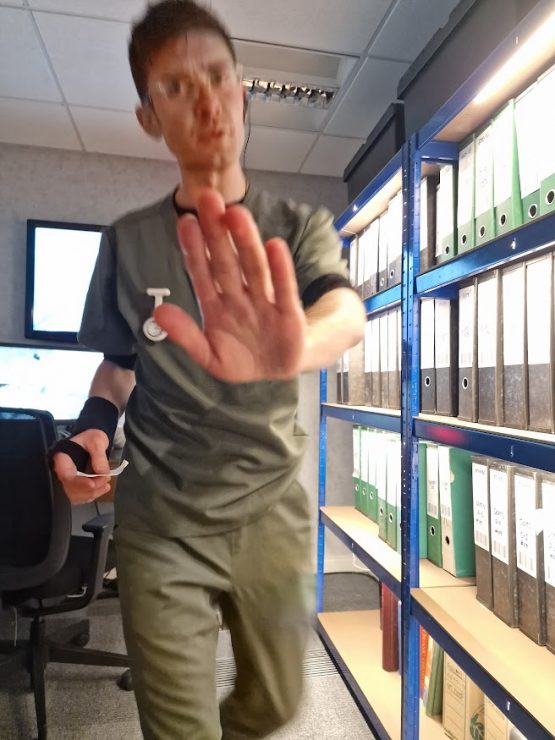Event Review: Saint Jude – Humanity and the machine explored in immersive drama
Posted by


 Reviewer and Photography: Frank Wainwright
Reviewer and Photography: Frank Wainwright
The rise and rise of AI is something to love and something to fear. If Swamp Motel’s immersive theatrical production is anything to go by – and I assure you that it is – then there are engaging and creepy experiences lying in wait in the near future. What might brands do with this?
Once upon a time – and I use this curtain-raiser of a phrase advisedly – brands finally latched onto in depth storytelling. Story immersion, story gameplay at events, often tallied creative scriptwriting with the experience. In recent years some storytellers have added a VR headset to draw participants into their new world, though too often these fall down when the tech is devised to replace rather than engage the imagination.
Saint Jude aims to immerse and build the engagement with tech, but without the awkward big glasses. It uses real building, real people acting, and a basic interactive device – headphones and a mic. You put these on in character. They are part of the script, so that putting them on forces you to more comopletely abandon the person you arrived as and play along with a theatrical game. It is a game that will bring you to your own unique ending…
 I’ll start back at the beginning, and also with a spoiler alert, though with Saint Jude’s extended run now finished, there’s probably nothing to spoil now.
I’ll start back at the beginning, and also with a spoiler alert, though with Saint Jude’s extended run now finished, there’s probably nothing to spoil now.
We – the audience participants – arrived at 100 Petty France. This is the building that both neighbours and looms over St James’ Park station. This run-down municipal edifice is all classic beige and grey council style on the inside and perfectly chosen as a setting for this grim dystopian vision. St Jude is a social science hospital lab where the volunteers – ‘us’ – come to communicate using Orwellian tech, with ‘sleepers’, coma patients.
From the get go, I found myself questioning everything around me. From a personal level, I know these buildings. I have been a reporter in the dark political nests behind the tourism facades in the Kremlin. I have found myself lost in Ceausescu’s private underground station. More recently I was wrongly held under suspicion in grimy towerblock in Jakarta. This place set off stay alert chills. I knew I was going to be manipulated, and I put up my defences – calm face, fake name and fake DoB already at the ready.
 As volunteers we then heard from smiling Stefan. He was the calming-yet-calculating scientist who set out the rules of communication with sleepers – and so the premise of the game. He soon had us going along with him to a clerical booth set out with an ‘Echosump’ machine, a phallic microphone and an incongruous little box of sand and mini rake. Older generations: for the Echosump, think Commodore 64, BBC Micro and Blakes 7 and you have the vibe.
As volunteers we then heard from smiling Stefan. He was the calming-yet-calculating scientist who set out the rules of communication with sleepers – and so the premise of the game. He soon had us going along with him to a clerical booth set out with an ‘Echosump’ machine, a phallic microphone and an incongruous little box of sand and mini rake. Older generations: for the Echosump, think Commodore 64, BBC Micro and Blakes 7 and you have the vibe.
Headphones deployed, and we were drawn into a question and answer interactive story told over the headphones by an AI voice character. Tech is advancing so quickly that the AI has surely been outdated by a couple of generations in the months between scripting Saint Jude and the end of this production run. This lead to at least one damning review, but most open-minded reviewers played along the game and doing so became immersed, as I did, by truly excellent and unsettling storytelling.
The chat and response method with the AI worked like the  page turner fantasy novels of the 1970s, and also owed a debt of heritage to choose-your-direction games from the classic Deus Ex to the more recent Detroit Become Human. These games force the player to align themselves with or against the authoritarian machine. Talking to my sleeper with the right open questions and direct answers triggered further different scripts to respond to.
page turner fantasy novels of the 1970s, and also owed a debt of heritage to choose-your-direction games from the classic Deus Ex to the more recent Detroit Become Human. These games force the player to align themselves with or against the authoritarian machine. Talking to my sleeper with the right open questions and direct answers triggered further different scripts to respond to.
I’m a natural rebel, but have also been an investigator, so I kept my cards close to my chest, checking my sand surreptitiously (discovering the hidden id card), whilst lying to the AI and playing the role of a good obedient worker.
And that – kind of – was the ending that I got, handed a good boy compliance report card at the end, though mitigated in my mind because it had my faked information printed onto it.
Only I, and perhaps the actor playing Stefan, knew something of the fully unique ending that continued to play out in my head. Stefan called me to his office for my ascribed ending  where some heinous actions of the Saint Jude organization were revealed to me. I like to think I left Stefan with a glimmer of doubt – had I been a prole who had been brainwashed into siding with the fascists or was I in fact the super-inspector of the facility coming to mystery shop Stefan’s out of hand operation? He and I will never know, especially as my impro skills were not up to speed with his excellent acting.
where some heinous actions of the Saint Jude organization were revealed to me. I like to think I left Stefan with a glimmer of doubt – had I been a prole who had been brainwashed into siding with the fascists or was I in fact the super-inspector of the facility coming to mystery shop Stefan’s out of hand operation? He and I will never know, especially as my impro skills were not up to speed with his excellent acting.
The astonishing thing was, though, that we had got to this point in about half an hour. In that mere hiccup of time I had been told a story in an immersive and interactive way that connected well enough for me to be creating my own ending whilst having a stab at acting back.
The potentials of Artificial Intelligence are legion. But the human brain is a very complex place where multiple scenarios can be played out concurrently. I was an actor in the script, a cog in the machine, a reviewer at a play and a visitor to the theatre all at once.
Swamp Motel understands this human complexity wonderfully well and St Jude was a very fine slice of immersive and interactive storytelling. I cannot praise St Jude more than to say that it is not jarringly out of place in the canon of its classic lineage of stories from 1984 to Deus Ex.
From a brand experience perspective, my main take away is this. Technology allows you to engage with people in new ways, but storytelling remains paramount to any immersive event. Since our parents first read to us, we have been attuned to the shared story experience and human interaction. If an event causes you to ask questions – of yourself or of others – then you have created a deeper engagement.
Saint Jude asked many questions of me, including some I hadn’t anticipated. It was truly memorable. My score for it is in the Echosump picture below.








